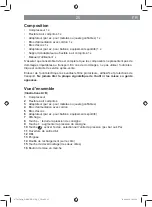
EN
16
2) Electrical Safety
a)
The power tool plug must match the outlet socket. The plug may not be
modi
fi
ed in any way. Do not use any adapter plugs with earthed (grounded)
power tools.
Unmodi
fi
ed plugs and matching outlets will reduce the risk of elec-
tric shock.
b)
Avoid body contact with earthed or grounded surfaces such as pipes, radi-
ators, ranges and refrigerators.
There is an increased risk of electric shock if
your body is earthed or grounded.
c)
Do not expose power tools to rain or wet conditions.
Water entering a power
tool will increase the risk of electric shock.
d)
Do not misuse the cable for carrying, suspending or unplugging the power
tool. Keep the cable away from heat, oil, sharp edges or moving parts.
Dam-
aged or entangled cables increase the risk of electric shock.
e)
When operating a power tool outdoors, only use extension cables which
are also suitable for outdoor use.
Use of an extension cable that is suitable for
outdoor use reduces the risk of electric shock.
f)
If operating the power tool in a damp location is unavoidable, use a residual
current device (RCD) protected supply.
Use of an RCD reduces the risk of
electric shock.
3) Personal Safety
a)
Stay alert, watch what you are doing and use common sense when operat-
ing a power tool. Do not use a power tool while you are tired or under the
in
fl
uence of drugs, alcohol or medication.
A moment of inattention while oper-
ating power tools may result in serious personal injury.
b)
Wear personal protective equipment and always wear safety goggles.
Wear-
ing protective equipment such as a dust mask, non-skid safety shoes, hard hat, or
hearing protection used for appropriate conditions will reduce the risk of personal
injury.
c)
Avoid accidental start-ups. Ensure the power tool is switched o
ff
before
connecting it to the power source and/or battery pack, picking up or carry-
ing the tool.
Carrying device with your
fi
nger on the switch or energising power
tools that have the switch on invites accidents.
d)
Remove any adjusting tool or wrench before turning the power tool on.
A tool
or wrench left attached to a rotating part of the device may result in injuries.
e)
Avoid adopting an abnormal posture. Keep proper footing and balance at
all times.
This enables better control of the power tool in unexpected situations.
f)
Wear suitable clothing. Do not wear loose clothing or jewellery. Keep your
hair, clothing and gloves away from moving parts.
Loose clothing, jewellery
or long hair may become entangled in moving parts.
g)
If dust extraction and collection equipment can be mounted, make sure they
are connected and used properly.
Use of dust extraction can reduce dust-re-
lated hazards.
07703_Inlay_DE-EN-FR-NL_A5_V2.indb 16
07703_Inlay_DE-EN-FR-NL_A5_V2.indb 16
11.08.2020 14:55:16
11.08.2020 14:55:16
















































